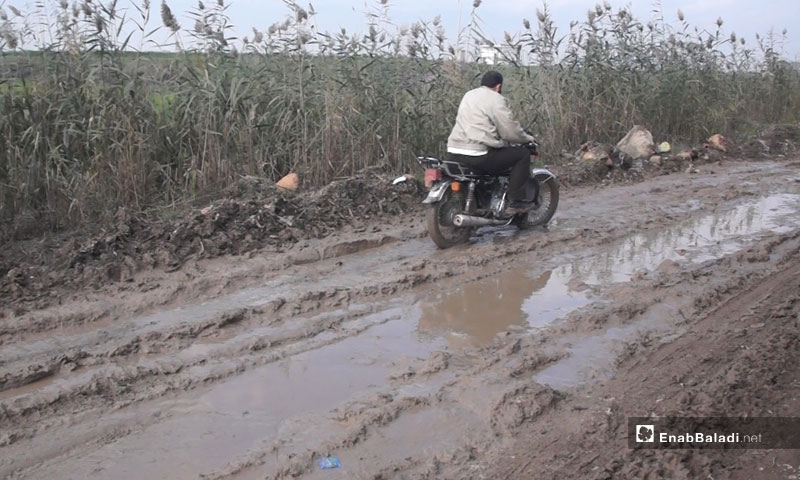



Wide agricultural areas in al-Ghab Plain, western rural Hama, drowned in the massive rainfalls and the deluges accompanying them in the past a few days.
Last week, the region of al-Ghab Plain and the villages on the slopes of the Shahshabo mountain witnessed intense rainfalls, never seen in pervious years. These were accompanied by deluges that caused the drowning of a wide space of agricultural lands and effected a rise in the level of water in most of the neighborhoods and streets of the al-Ghab Plain.
“Abulkareem Darwish,” director of the local council of the “Bab al-Taqa” village, described to Enab Baladi the suffering of the village’s population, five thousand persons, caused by the latest massive rainfalls.
The lack of a sewer system in the village caused the flooding of the streets and drowned them with rain water, the thing that led to several car accidents, a few of which resulted in fatalities, in addition to the difficulty faced by vehicles and passersby, especially students.
Al-Darwish pointed out that the village of “Bab al-Taqa,” despite being a tourist destination with natural landscapes, lakes and restaurants, suffers missing services and is always neglected by the funding sources and excluded by the support of organizations.
He also called on all the concerned humanitarian organizations and associations to help the village’s people.
Enab Baladi talked to Shaher Abu Hassan, director of the “al-Hawash” village’s council, who referred to the suffering of the village’s people due to the conditions effected by the rainfalls, including difficulty in moving on minor streets, which are not asphalted, particularly the road linking the two villages of al-Hawash and Bait al-Rass, considered one of the major roads, as it is usually used for transporting injured people and the evacuation of civilians.
For his part, Bilal al-Ghabi, from “al-Haweez” village, said that the rain water has drowned about 1500 dunams of agricultural lands because the street gutters are blocked or flooded.
He added that the poor condition of the streets, and their being filled with holes led to covering all, major and secondary, public streets in the village with rain water.
The agricultural engineer Anas Abu Tarboush explained to Enab Baladi that the past a few days witnessed massive rainfalls, exceeding last year’s ratios, as the region, including Syria, was affected by forceful rain and snow storms, accompanied by wind, the speed of which reached 30km per hour.
The massive amounts of water flooded the agricultural lands in al-Ghab Plain, from Qalaat al-Madiq, in the south, to al-Qarqour village, in the north, he pointed out.
He also indicated the weakness of the agricultural gutters’ absorptive capacity and the complete blockage of some of them due to lacking cleaning-based maintenance operations in the past years in al-Ghab Plain with its scarce resources. This led to a deficiency in discharging the water from the agricultural lands of al-Ghab Plain in general, especially those cultivated with the strategic crop of wheat.
Engineer Abu Tarboush said that the overall area cultivated with wheat in the al-Ghab Plain, both hard and soft, is estimated with about 50 thousand dunams, warning that this year’s production of wheat might decline if the land continues to drown with water, especially that the rise in the water’s temperature, accompanying sunshine, might damage the leaves and the roots of the plants that will develop a breathing difficulty. And then, the plants will shrivel away, and their number will lessen in the per unit area, which will cause a decline in the dunam’s production while the number of herbs will increase at the disadvantage of wheat.
The engineer confirmed that the deluges in the countryside overlooking the Shahshabo mountain and the irrigation channels, especially the “G3,” which the Qatari Red Crescent maintained and rehabilitated in the previous period led to soil erosion, deviation of the surface soil and a rise in mud amounts in the agricultural channels.
The past a few days witnessed massive rainfalls and exploded springs and rivers in the slopes of the Mount Zāwiya, overlooking the region of al-Ghab Plain, which have been suffering drought for years.
In Hama, the last season of wheat registered a decline in production and quantity due to late rainfalls, which went lacking in winter.
For 2018, Syria’s wheat production was estimated with about 1.8 million tons in the eastern region, and al-Ghab Plain is considered the second food basket in Syria, after al-Hasakah province.
The “General Directorate of Agriculture, Livestock and Irrigation” estimated the area to be cultivated in the 2019 season in rural Hama with 18 thousand dunams of rain-fed hard wheat, 54 thousand dunams of irrigated soft wheat and 78 thousand dunams of irrigated hard wheat.
if you think the article contain wrong information or you have additional details Send Correction